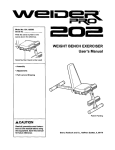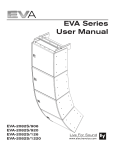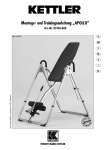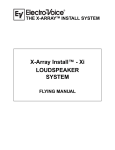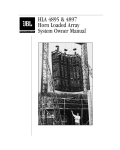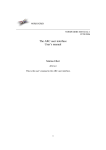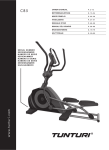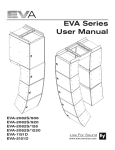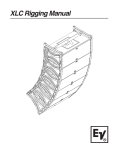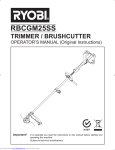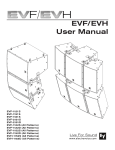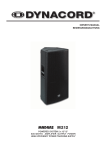Download X-Array - Flying Manual and Structural Ratings
Transcript
X-ARRAY™ CONCERT SYSTEMS Flying Manual and Structural Ratings X-Array™ Loudspeaker Systems RIGGING-SAFETY WARNING This document details general rigging practices appropriate to the sound industry, as they would apply to the rigging of Electro-Voice X-Array™ loudspeaker systems. It is intended to familiarize the reader with standard rigging hardware and techniques for suspending X-Array™ loudspeaker systems overhead. Only persons with the knowledge of proper hardware and safe rigging techniques should attempt to suspend any sound systems overhead. Prior to suspending any Electro-Voice X-Array™ loudspeaker systems overhead, it is essential that the user be familiar with the strength ratings, rigging techniques and special safety considerations outlined in this manual. The rigging techniques and practices recommended in this manual are, of necessity, in general terms to accommodate the many variations in loudspeaker arrays and rigging configurations. As such, the user is expressly responsible for the safety of all specific X-Array™ loudspeaker-array designs and rigging configurations as implemented in practice. All of the general rigging material contained in this manual is based on the best available engineering information concerning materials and practices, as commonly recognized in the United States, and is believed to be accurate at the time of the original printing. As such, the information may not be directly applicable in other countries. Furthermore, the regulations and requirements governing rigging hardware and practices may be superseded by local regulations. It is the responsibility of the user to ensure that any Electro-Voice loudspeaker system is suspended overhead in accordance with all current federal, state and local regulations. All specific material concerning the strength ratings, rigging techniques and safety considerations for the X-Array™ loudspeaker systems is based on the best available engineering information concerning the use and limitations of the products. Electro-Voice continually engages in testing, research and development of its loudspeaker products. As a result, the specifications are subject to change without notice. It is the responsibility of the user to ensure that any Electro-Voice loudspeaker system is suspended overhead in accordance with the strength ratings, rigging techniques and safety considerations given in this document and any manual update notices. All non-Electro-Voice associated hardware items necessary to rig a complete X-Array™ loudspeaker array (grids, chain hoists, building or tower supports and miscellaneous mechanical components) are the responsibility of others. Electro-Voice February, 1998 X-Array™ Loudspeaker Systems TABLE OF CONTENTS PAGES RIGGING-SAFETY WARNING 0. INTRODUCTION 1. X-ARRAY™ RIGGING SYSTEM 1.1 Overview of the X-Array™ Flying Systems ............................................................................ 1-2 1.2 Loudspeaker Enclosure Details ............................................................................................. 2-5 1.3 Rigging Hinge Details ............................................................................................................ 5-7 1.4 Rigging Strap Details ............................................................................................................. 7-8 1.5 Grid Details ............................................................................................................................... 8 2. X-ARRAY™ FLYING TECHNIQUES 2.1 Enclosure and Horn Orientation .......................................................................................... 9-10 2.2 Adjusting the Vertical Angles ............................................................................................. 10-12 Using the Xrsl (long wire-rope rigging strap) Between Enclosures ........................................ 10 Using the Xrsl (at the Grid ................................................................................................. 10-11 Using the Xrss (short wire-rope rigging strap) Between Enclosures ................................. 11-12 Using the Xrss at the Grid ...................................................................................................... 11 Multiple Enclosure Angles ...................................................................................................... 12 2.3 Adjusting the Horizontal Angles ......................................................................................... 12-13 2.4 Balancing and Distributing the Load .................................................................................. 13-14 Array Load Distribution ...................................................................................................... 13-14 Balancing the Grid .................................................................................................................. 14 2.5 Using Pull-Up Lines ........................................................................................................... 14-15 Pull-Up Line Techniques ................................................................................................... 14-15 CAUTIONS for Pull-Up Lines ................................................................................................. 15 3. RIGGING-STRENGTH RATINGS, SAFETY .............................................................................. 15-23 FACTORS AND SPECIAL CONSIDERATIONS 3.1 Working-Load Limit and Safety Factors ...................................................................... 15-16 Definitions .................................................................................................................... 15-16 CAUTIONS for Working-Load Limits and Safety Factors ................................................. 16 3.2 Structural Rating Overview .......................................................................................... 16-17 3.3 Simplified Structural-Rating Guidelines ............................................................................ 17 The Guidelines ................................................................................................................. 17 CAUTIONS for the Simplified Structural-Rating Guidelines ........................................ 17-19 Discussion of Array Examples .......................................................................................... 19 X-Array™ Loudspeaker Systems 3.4 Complex Structural-Rating Analysis .................................................................................. 19-20 Rear Rigging Point Structural-Strength Rating .................................................................. 19-20 (Xrhg, Xrhp, Xrhl & NH32102-2) Xrhg (grid hinge) Xrhp (pick-up hinge) Xrhl (linking hinge) NH32102-2 (New Haven double-stud swivel-ring fitings) Front Rigging Point Structural-Strength Rating ................................................................. 20-21 (Xrss, Xrsl & NH32102-2) Xrss (short wire-rope rigging strap) Overall Enclosure Structural-Strength Rating ........................................................................ 21 CAUTIONS for a Complex Structural-Rating Analysis ........................................................... 21 3.5 Special Considerations ...................................................................................................... 21-23 Double-Stud Fittings .......................................................................................................... 21-23 Flying a Single Enclosure ....................................................................................................... 23 3.6 Electro-Voice Structural Analysis Procedures ........................................................................ 23 4. RIGGING INSPECTION AND PRECAUTIONS .......................................................................... 23-24 5. REFERENCES ................................................................................................................................ 24 Rigging References Mechanical Engineering References Acoustical Engineering References APPENDICES .................................................................................................................................. 24 A. SERVICING THE X-ARRAY™ RIGGING ................................................................................. 25 B. X-ARRAY™ RIGGING ACCESSORIES ................................................................................... 25 X-Array™ Loudspeaker Systems 0. INTRODUCTION The X-Array™ product line represents important advancements in concert-sound-reinforcement technology. The design goals called for the highest acoustic-output capability with the highest fidelity, in lightweight, compact enclosures that were easy to array. The development began with a clean sheet of paper and took an integrated approach. The individual loudspeaker drivers, horns, enclosures, rigging hardware and system configurations were designed from the ground up specifically for this high-performance application. A brief description of the X-Array™ product line is included below. Consult the individual system engineering data sheets for detailed specifications. them. See Appendix A. Servicing the X-Array™ Rigging for service information. 1. X-ARRAY™ RIGGING SYSTEM Xf: Far-field, two-way, MB/HF loudspeaker system with a 40°H x 20°V coverage pattern. The system has two ND12A 305-mm (12-in.) MB drivers and two ND5-16 76-mm (3-in.) HF compression drivers. The Xf utilizes the full-size X-Array™ enclosure shell and the standard X-Array™ flying hardware. Xn: Near-field, three-way, LF/MB/HF loudspeaker system with a rotatable 60° x 40° coverage pattern. The system has one EVX-180B 457-mm (18-in.) woofer, one ND12A 305-mm (12-in.) MB driver and one ND5-16 76-mm (3-in.) HF compression driver. The Xn utilizes the fullsize X-Array™ enclosure shell and the standard X-Array™ flying hardware. Xb: Bass loudspeaker system with two EVX-180B 457-mm (18-in.) woofers. The Xb utilizes the full-size X-Array™ enclosure shell and the standard X-Array™ flying hardware. Xds: Subwoofer loudspeaker system with two EVX-180B 457-mm (18-in.) woofers. The Xds utilizes the double-wide X-Array™ enclosure shell and does not have flying hardware. Xcn: Compact near-field, two-way, MB/HF loudspeaker system with a rotatable 60° x 40° coverage pattern. The system has one ND12A 305-mm (12-in.) MB driver and one ND5-16 76-mm (3-in.) HF compression driver. The Xcn utilizes the halfsize X-Array™ enclosure shell and the standard X-Array™ flying hardware. Xcb: Compact bass loudspeaker system with one 457-mm (18-in.) EVX-180B woofer. The Xcb utilizes the half-size X-Array™ enclosure shell and the standard X-Array™ flying hardware. Numerous accessories are available to complete an X-Array™ loudspeaker system, including rigging hardware, digital electronic controllers, power amplifiers, cables, racks, cases, dolly boards and speaker covers. See Appendix B. X-Array™ Rigging Accessories for a list of available accessories and where to purchase 1.1 Overview of the X-Array™ Flying System The X-Array™ rear-hinge/front-strap flying system makes constructing arrays easy, predictable and repeatable. The hinging concept, combined with the trapezoidal enclosures, allows arrays to be constructed with the least possible spacing between enclosures. A basic two-enclosure flying system is shown in Figure 1 that illustrates the integral components that make up a typical X-Array™ flying system. All of the flying X-Array™ loudspeaker systems utilize horizontal rigging-track hardware on the back of the enclosure (at both the top and bottom) and vertical rigging-track hardware on the front of the enclosures (at both the left and right sides). The rear rigging-hinge hardware provides the page 1 X-Array™ Loudspeaker Systems primary support for the loudspeaker enclosures, while the front rigging hardware is mainly for aiming the enclosures vertically. (The front does provide some secondary support, however.) Figure 1a illustrates an array column suspended with a grid. Like the loudspeaker systems, the grid utilizes horizontal rigging-track hardware at the back and vertical rigging-track hardware at the front. The top enclosure is secured to the grid with two quick-release Xrhg grid hinges at the rear, and two quick-release Xrss short wire-rope rigging straps at the front. The grid hinge has only one possible vertical attachment position on both the enclosure and the grid. The front straps, however, have six possible vertical attachment positions to choose from on the enclosure and two possible vertical attachment positions to choose from on the grid. The grid hinges allow the enclosure to pivot from its top back corner. The vertical angle of the top enclosure, relative to the grid, is set by the linear position of the front rigging straps in the track on the front of the enclosure and on the grid. The bottom enclosure shown in Figure 1a is linked to the top enclosure with two quick-release Xrhl linking hinges at the rear and two quick-release Xrsl long wire-rope rigging straps at the front. The linking hinges allow the bottom enclosure to pivot from the back corner of the top enclosure. The vertical angle of the bottom enclosure, relative to the top enclosure, is set by the linear position of the front rigging straps in the track on the front of the top and bottom enclosures. Additional enclosures may be linked together in the same fashion, as long as the working-load limits for any of the enclosures, rigging hinges or straps are not exceeded. The array column is raised into position by a motorized chain hoist of sufficient load rating. Figure 1a shows the short Xrss rigging straps securing the top enclosure to the grid and the long Xrsl rigging straps linking the two enclosures because this is the most common configuration; however, the straps may be interchanged in many circumstances. When the short Xrss rigging straps are used between the top enclosure and the grid, the enclosure may be angled upward relative to the grid or downward a moderate amount. When the long Xrsl rigging straps are used between the top enclosure and the grid, the enclosure may be hung parallel to the grid, or angled downward substantially relative to the grid. When the long Xrsl straps are used between enclosures, the bottom enclosure may be hung parallel to the top enclosure or angled downward substantially relative to the top enclosure. When the short Xrss straps are used between enclosures, the bottom enclosure may be hung parallel page 2 to the top enclosure or angled downward a moderate amount relative to the top enclosure. When a grid is used, each array column must be balanced by adjusting the position of the grid hanger towards the front or back until the grid hangs level. Several of the grids may be connected together horizontally and raised in unison. When using the grid, the splay angle between array columns is adjusted by the positioning of the grid retractable-coupler arms. In permanent installations, the motorized chain hoists and grids are sometimes eliminated, and the loudspeaker columns can be secured directly to the building structure. This application is shown in Figure 1b. The back of the top enclosure is suspended with two Xrhp pickup hinges. Each Xrhp pickup hinge utilizes standard chain that will accept chain connectors, shackles or other standard rigging hardware which are, in turn, secured to the building structure via custom wire-rope or chain assemblies. The front of the enclosure is suspended by two New Haven NH32102-2 double-stud swivel-ring fittings attached to the front track of the enclosure and which are, in turn, secured to the building structure via two custom wire-rope or chain rigging assemblies. The hardware and techniques used to secure and angle the bottom enclosure to the top enclosure are identical to the previously described case where a grid was employed. In installations where a custom grid is employed that does not use track that is compatible with the X-Array™ Xrhg grid hinge or the Xrss or Xrsl rigging straps, the Xrhp pickup hinge and custom wire-rope rigging straps that utilize New Haven NH32102-2 double-stud swivel-ring fittings can be used to suspend the top enclosure as illustrated in Figure 1b. Note that the weight of an array can be quite substantial and the grid, chain hoists and building structural supports used to suspend the array must be capable of supporting such a load with a sufficient safety factor. The reader is directed to section 5. References of this manual for a list of rigging references (for background in general rigging practice) and mechanical engineering references (for background in structural engineering analysis). 1.2 Enclosure Rigging Hardware Details All of the flying X-Array™ models utilize identical rigging hardware, and they all have the same strength ratings. Figure 2 shows key dimensions, weights and the centers of gravity for all of the X-Array™ systems. A proprietary high-strength aluminum-alloy track is used at the back of the enclosures near the top O 9.0 TYP O 9.0 TYP 733.2 mm (28.87 in.) 758.8 mm (29.88 in.) CL 584.2 mm (23.00 in.) WEIGHT: 87.1 kg (192 lb) 733.2 mm (28.87 in.) WEIGHT: WITHOUT 87.1 kg (192 lb) WEIGHT: EXTERNAL RIGGING: 87.1 kg (192 lb) WITH EXTERNAL RIGGING: 90.2 kg (199 lb) WEIGHT: WITHOUT EXTERNAL RIGGING: 87.1 kg (192 lb) WITH EXTERNAL RIGGING: 90.2 kg (199 lb) 758.8 mm (29.88 in.) CL 584.2 mm (23.00 in.) 384.1 mm (15.12 in.) 409.2 mm (16.11 in.) 914.4 mm (36.00 in.) 914.4 mm (36.00 in.) 441.3 mm (17.38 in.) 457.2 mm (18.00 in.) FIGURE 2b - Xn SYSTEM FIGURE 2a - Xf SYSTEM 736.6 mm (28.98 in.) 353.8 mm (13.93 in.) 18° TYP. O 9.0 TYP 733.2 mm (28.87 in.) CL WEIGHT:WITHOUT 83.5 kg (184 lb) WEIGHT: EXTERNAL RIGGING: 83.5 kg (184 lb) WITH EXTERNAL RIGGING: 86.6 kg (191 lb) 758.8 mm (29.88 in.) 584.2 mm (23.00 in.) 667.2 mm (26.27 in.) C L 1166 mm (45.92 in.) 438.5 mm (17.26 in.) 914.4 mm (36.00 in.) 758.8 mm (29.88 in.) WEIGHT: 121 kg (267 lb) 423.3 mm (16.67 in.) 914.4 mm (36.00 in.) 457.2 mm (18.00 in.) 457.2 mm (18.00 in.) page 3 FIGURE 2d - Xds SYSTEM FIGURE 2c - Xb SYSTEM FIGURE 2 - X-ARRAY LOUDSPEAKER SYSTEMS X-Array™ Loudspeaker Systems 353.8 mm (13.93 in.) 353.8 mm (13.93 in.) FIGURE 2f - Xcb SYSTEM FIGURE 2 (cont’d) - X-ARRAY LOUDSPEAKER SYSTEMS 292.1 mm (11.50 in.) 595.9 mm (23.46 in.) 584.2 mm (23.00 in.) FIGURE 2e - Xcn SYSTEM 301.6 mm (11.88 in.) 595.9 mm (23.46 in.) 584.2 mm (23.00 in.) 391.2 mm (15.40 in.) WEIGHT: 60.8 kg (134 lb) C L 733.2 mm (28.87 in.) 758.8 mm (29.88 in.) 9.0° TYP 353.8 mm (13.93 in.) 433.6 mm (17.07 in.) 758.8 mm (29.88 in.) C L 353.8 mm (13.93 in.) 9.0° TYP 733.2 mm (28.87 in.) WEIGHT: 55.8 kg (123 lb) X-Array™ Loudspeaker Systems and bottom for the attachment of two Xrhg, Xrhl or Xrhp rigging hinges. The track/bracket assembly is extruded as a single piece. One assembly ties into the back and top of the enclosure, while a second assembly ties into the back and bottom of the enclosure. High-strength, aluminum-alloy bars inside the enclosure tie the top and bottom track/bracket assemblies together, minimizing the load applied to the enclosure shell. The track dimensions are similar to the widely used heavyduty aircraft L-track (such as the New Haven NH34030-3HD or ATM Fly-Ware™ ATM-TRACK). The cutouts in the rear rigging track are shown in Figure 3a. The large cutout in the center of the track is for inserting the rigging hinges. The small holes in the base of the track are for locking the rigging hinges. The round cutouts on either side are provided so that two New Haven NH32102-2 double-stud swivel-ring fittings may be installed for light-duty lifting applications and for pull-ups. Key dimensions for the rear rigging hardware are presented in Figure 3a. (See section 3. RiggingStrength Ratings, Safety Factors and Special Considerations for a detailed discussion of the structural strength of the enclosure rear rigging points.) At the front of the enclosure is another pair of proprietary high-strength, aluminum-alloy track/ bracket assemblies which are also extruded as a single piece. One assembly ties into the left side, top, bottom of the enclosure, while a second assembly ties into the right side, top and bottom of the enclosure. The front track extends from the top to the bottom on both sides of the enclosure, eliminating the load applied to the enclosure shell. These track dimensions are also similar to the widely used heavy-duty aircraft L-track (New Haven NH34030-3HD or ATM Fly-Ware™ ATMTRACK). On both sides of the enclosure, the front rigging track has six cutouts near the top and bottom, as shown in Figure 3b. The New Haven NH32102-2 double-stud swivel-ring fittings on the Xrss and Xrsl wire-rope rigging straps may be installed at any of the cutouts. The relative angle between a pair of enclosures (or the top enclosure and the grid) is set by the position of the front rigging-strap fittings in the track cutouts. Key dimensions for the front rigging hardware are presented in Figure 3b. (See section 3. Rigging-Strength Ratings, Safety Factors and Special Considerations for a detailed discussion of the structural strength of the enclosure front rigging points.) To facilitate the installation and removal of the linking hinges, alignment feet are installed on the top and bottom of the X-Array™ enclosures. Male feet (protruding feet) are located on the bottom of the enclosures, while female feet (concave page 4 X-Array™ Loudspeaker Systems CUTOUT FOR LOCKING DOUBLE-STUD FITTING HOLE FOR RIGGING HINGE LOCKING PIN 48.0 mm (1.89 in.) the chain near the ends of the track, as shown in Figure 5a. (Note: If one grid hinge is installed incorrectly with the chain at the center of the track, the second grid hinge will not fit into the track cutout.) Key dimensions for the Xrhg grid hinges and the enclosure are presented in Figures 4a and 5a. To install an Xrhg grid hinge into the track of an enclosure, grasp one of the hinge bases and CUTOUT FOR INSERTING RIGGING HINGES AND DOUBLE-STUD FITTINGS FIGURE 3a - ENCLOSURE REAR RIGGING TRACK 79.0 mm (3.11 in.) TYP. 25.4 mm (1.00 in.) TYP. FIGURE 3b - ENCLOSURE FRONT RIGGING TRACK FIGURE 3 - ENCLOSURE RIGGING HARDWARE DETAIL dishes) are located on the top. When one enclosure is stacked or lowered on top of another, the male feet on the bottom of the upper enclosure slide into the female feet on the top of the lower enclosure, automatically aligning the enclosures. If the enclosures do not self align, a light sideways push is all that is needed to make the feet engage and align. These features allow fast assembly and disassembly of large loudspeaker arrays in touring applications. 1.3 Rigging Hinge Details Xrhg Grid Hinge: Two Xrhg grid hinges are used to attach the back of an X-Array™ enclosure to the back of an X-Array™-compatible grid. (See section 1.5 Grid Details for a discussion of the grid.) Each grid hinge consists of two precisionmachined steel bases connected by an alloy-steel chain, as shown in Figure 4a. Each grid-hinge base has a locking pin which locks the hinge in place horizontally in the track on the grid or X-Array™ enclosure. (See section 3. RiggingStrength Ratings, Safety Factors and Special Considerations for a detailed discussion of the structural strength of the grid hinges.) The Xrhg grid rigging hinges need not be installed in the top enclosure and the grid simultaneously. The length of chain allows the grid hinges to be installed in the grid first. The grid can then be floated above the top enclosure while the other ends of the grid hinges are installed in the track at the rear of the enclosures. The grid hinges must be used in pairs and must be installed with firmly insert the hinge base into the long center cutout in the track, pressing in until the springloaded locking pin is fully retracted. Then apply pressure to slide the hinge base sideways towards the end of the track until the spring-loaded locking pin drops into the hinge-locking-pin hole in the base of the track. Once the locking pin is fully engaged, the grid hinge base will be immovable in the track. ALWAYS CHECK TO MAKE SURE THE GRID-HINGE BASES ARE SECURELY LOCKED INTO THE TRACK, AND THAT THE LOCKING PINS ARE FULLY ENGAGED IN THE TRACK BEFORE LIFTING ANY LOUDSPEAKER ENCLOSURES OVERHEAD. Use the same technique for installing the other end of the Xrhg grid hinge in the track at the rear of the grid. To remove the Xrhg grid hinge, grasp the lockingpin knob and pull out while applying pressure on the hinge to slide the hinge base toward the long cutout at the center of the track. The hinge base page 5 X-Array™ Loudspeaker Systems arms at the center of the track, the second linking hinge will not fit into the track cutout.) Key dimensions for the Xrhl rigging hinges and the enclosure are presented in Figures 4b and 5b. To install an Xrhl into the track of a pair of enclosures stacked one on top of the other, grasp both of the hinge bases and firmly insert both of the hinge bases simultaneously into the long center cutouts in the track of both enclosures, pressing in until both spring-loaded locking pins are fully retracted. Then apply pressure to slide the hinge bases sideways towards the end of the track until both spring-loaded locking pins drop into the hinge-locking-pin holes in the base of the track on both enclosures. Once the locking pins are fully engaged, the linking hinge bases will be immovable in the track. ALWAYS CHECK TO MAKE SURE THE LINKING-HINGE BASES ARE SECURELY LOCKED INTO THE TRACK, AND THAT THE LOCKING PINS ARE FULLY ENGAGED IN THE TRACK BEFORE LIFTING ANY LOUDSPEAKER ENCLOSURES OVERHEAD. will come out of the track once it is aligned with the center cutout. For added safety, the locking pin has a special shape which engages with the track to prevent it from vibrating out of the track hole during use. If the locking-pin knob seems difficult to pull out when removing the hinge, wiggle the hinge base while pulling out on the knob. When the hinge locking pin is centered in the track hole, the pin will easily release. Xrhl Linking Hinge: Two Xrhl linking hinges are used to link a pair of X-Array™ enclosures together at their adjacent back corners. Each linking hinge consists of two precision-machined steel bases connected by a heavy-duty steel hinge, as shown in Figure 4b. The hinge arms pivot, allowing the enclosures to pivot at their back corners. Each linking-hinge base has a locking pin which locks the hinge in place horizontally in the rear track of the enclosure. (See section 3. Rigging-Strength Ratings, Safety Factors and Special Considerations for a detailed discussion of the structural strength of the linking hinges.) An Xrhl linking hinge must be installed in the top and bottom enclosures simultaneously. The linking hinges must also be used in pairs and installed with the hinge arms near the ends of the rigging track as shown in Figure 5b. (Note: If one linking hinge is installed incorrectly with the hinge page 6 To remove the Xrhl linking hinge, grasp both of the locking-pin knobs and pull out while applying pressure on the hinge to slide the hinge base toward the long cutout at the center of the track. The hinge base will come out of the track once it is aligned with the center cutout. Like the grid hinge, the locking pin has a special shape which engages with the track to prevent it from vibrating out of the track hole during use. If the locking-pin knob seems difficult to pull out when removing the hinge, wiggle the hinge base while pulling out on the knob. When the hinge locking pin is centered in the track hole, the pin will easily release. Xrhp Pickup Hinge: Two Xrhp pickup hinges are used to attach to the back of the top X-Array™ enclosure in a column to lift the array where no grid is used or where a custom grid that is not X-Array™ compatible is used. Each pickup hinge consists of a single precision-machined steel base connected by an alloy-steel chain, as shown in Figure 4c. The pickup-hinge base has a locking pin which locks it in place when inserted into the rear track of an X-Array™ enclosure. Standard chain-link couplers or connectors can be used to attach the 7.95-mm (5/16-in.) alloysteel chain of the Xrhp to standard rigging hardware (such as shackles, other chains, wire-rope slings, etc.), which are in turn secured to a custom grid or directly to the building structure. (See section 3. Rigging-Strength Ratings, Safet Factors and Special Considerations for a detailed discussion of the structural strength of the pickup hinges.) The pickup hinges must be used in pairs and installed with the chain near the ends of the track, X-Array™ Loudspeaker Systems as shown in Figure 5c. (Note: If one pickup hinge is installed incorrectly with the chain at the center of the track, the second pickup hinge will not fit into the track cutout.) Key dimensions for the Xrhp rigging hinges and the enclosure are presented in Figures 4c and 5c. To install an Xrhp pickup hinge into the track of an enclosure, grasp the hinge base and firmly insert it into the long center cutout in the track, pressing in until the spring-loaded locking pin is fully retracted. Then apply pressure to slide the hinge base sideways towards the end of the track until the spring-loaded locking pin drops into the hinge-locking-pin hole in the base of the track. Once the locking pin is fully engaged, the pickup hinge base will be immovable in the track. ALWAYS CHECK TO MAKE SURE THE PICKUPHINGE BASES ARE SECURELY LOCKED INTO THE TRACK, AND THAT THE LOCKING PINS ARE FULLY ENGAGED IN THE TRACK BEFORE LIFTING ANY LOUDSPEAKER ENCLOSURES OVERHEAD. cussion of the grid.) When the short Xrss rigging straps are used between the top enclosure and the grid, the top enclosure may be angled upward relative to the grid or downward a moderate amount. When the long Xrsl rigging straps are used between the top enclosure and the grid, the enclosure may be hung parallel to the grid, or angled downward substantially relative to the grid. Two Xrsl straps are typically used to link two enclosures together at the front; however, the Xrss may be substituted. When the long Xrsl straps are used between enclosures, the bottom enclosure may hung parallel to the top enclosure or angled downward substantially relative to the top enclosure. When the short Xrss straps are used between enclosures, the bottom enclosure may hung parallel to the top enclosure or angled downward a moderate amount relative to the top enclosure. (See the section 2.2 Aiming the Enclosures for details.) To attach the front of an X-Array™ enclosure to a building structure, custom wire-rope assemblies To remove the Xrhp pickup hinge, grasp the locking-pin knob and pull out while applying pressure on the hinge to slide the hinge base toward the long cutout at the center of the track. The hinge base will come out of the track once it is aligned with the center cutout. For added safety, the locking pin has a special shape which engages with the track to prevent it from vibrating out of the track hole during use. If the locking-pin knob seems difficult to pull out when removing the hinge, wiggle the hinge base while pulling out on the knob. When the hinge locking pin is centered in the track hole, the pin will easily release. 1.4 Rigging Strap Details Two rigging straps (either two Xrss straps or two Xrsl straps) are used to attach a pair of enclosures together at the front, or to attach the front of the top enclosure to an X-Array™-compatible grid. The short Xrss wire-rope rigging strap, shown in Figure 6a, and the long Xrsl wire-rope rigging strap, shown in Figure 6b, are identical except for their length. Both consist of two New Haven NH32102-2 double-stud swivel-ring fittings connected together with a 4.76-mm (.188-in.) diameter, galvanized and black-plastic-coated, aircraft wire rope. (See section 3. Rigging-Strength Ratings, Safety Factors and Special Considerations for a detailed discussion of the structural strength of the rigging straps.) Two Xrss straps are typically used to attach the front of the top enclosure to an X-Array™-compatible grid as shown in Figure 7a; however, the Xrsl may be substituted. Key dimensions for the front rigging straps on the enclosures are presented in Figure 7a. (See section 1.5 Grid Details for a dis- may be fabricated using the New Haven NH32102-2 double-stud swivel-ring fitting. That same fitting may be used on custom wire-rope assemblies to secure the front of an enclosure to a custom grid that does not have track at the front. In certain circumstances, two New Haven NH32102-2 double-stud swivel-ring fittings may page 7 X-Array™ Loudspeaker Systems ring. When locked, the fitting will be immoveable in the track and the locking ring of the fitting may not be lifted. To remove the fitting, reverse the procedure. ALWAYS CHECK TO MAKE SURE THAT THE DOUBLE-STUD FITTING IS SECURELY LOCKED INTO THE TRACK, AND THAT THE SAFETY PIN IS EXTENDED OVER THE LOCKING RING BEFORE LIFTING ANY LOUDSPEAKER ENCLOSURE OVERHEAD. 1.5 Grid Details be used on custom wire-rope assemblies to attach to the rigging track on the back of an X-Array™ enclosure as shown in Figure 7b. Key dimensions for the rigging straps on the enclosures are presented in Figure 7b. In light lifting applications, double-stud-fitting custom assemblies could be used instead of the Xrhp pickup hinges. The reader is cautioned that THE STANDARD DOUBLE-STUD FITTINGS ARE NOT AS STRONG AS THE Xrhp, Xrhg and Xrhl RIGGING HINGES. (See section 3. Rigging Strength-Ratings, Safety Factors and Special Considerations for a detailed discussion of the structural strength of the NH32102-2 fittings and the rigging hinges.) To attach the double-stud swivel-ring fittings to the enclosure rigging track, as shown in Figure 7, grasp the fitting between the thumb and first two fingers. Push in the spring-loaded safety locking pin with your free hand and lift the outer locking ring over the pin by pressing with your thumb. Continue to press with your thumb until the two legs of the fitting are fully exposed. Insert the two round feet on the end of the legs into the round cutouts in the track and slide the fitting to the desired position. Center the main body of the fitting over one of the track cutouts, with the feet located on either side (i.e., the feet positioned directly under the teeth of the track). Release the outer locking ring. The round protrusion on the bottom of the fitting should lock into the round cutout in the track, with the locking ring retracting to its normal position, allowing the safety pin to reappear and extend over the locking ring. If the fitting does not lock into the track, nudge it along the track and wiggle as necessary until it settles into position. If the outer locking ring does not fully retract, push the ring towards the track until the safety pin reappears and extends over the locking page 8 ATM Fly-WareTM manufactures the MEGS-4000-T grid, shown in Figure 8, specifically for the X-Array™ loudspeaker systems. The grid is completely compatible with the X-Array™ systems, and has track on the front and rear for connecting to the top enclosure in an array column. The track on the rear of the grid, shown in Figure 8b, has a single large cutout for inserting the Xrhg grid hinges, and has hinge locking-pin holes similar to the track on the rear of the enclosures. Standard double-stud aircraft fittings cannot be used at the rear of the grid. The track on the front of the grid, shown in Figure 8c, provides two attachment positions for the Xrsl or Xrss rigging straps. A grid suspending a column of loudspeakers is balanced, front to back, by adjusting the position of the hanger shown in Figure 8d. The hanger is secured to the center bar with bolts or quick-release pins. Multiple positions for the hanger are available from the back to the front of the grid. Multiple grids can be linked together with retractable couplers, shown in Figure 8e, the position of which sets the splay angle between adjacent columns. Each grid comes with two long couplers in the front and two short couplers in the rear. The couplers on one side of the grid have male ends while the couplers on the other side of the grid have female ends. This allows several grids to be linked together by inserting the male ends of one grid’s couplers into the female ends of another grid’s couplers, as shown in Figure 8f. The couplers are secured to the front and rear grid bars with bolts or quick-release pins. The front and rear couplers may be swapped from front to rear to attain a wider range of splay angles. Two examples are shown in Figures 8g and 8h. The working-load structural-strength ratings of the X-Array™ loudspeaker systems allow a maximum weight of 726 kg (1,600 lb) to be suspended in a single column, which is well within the workingload limit of the ATM Fly-Ware™ MEGS-4000-T grid. When using the MEGS-4000-T grid, always follow the manufacturers instructions, recommendations and safety precautions, and never exceed any structural limit as provided by ATM. X-Array™ Loudspeaker Systems FIGURE 8 - ATM FLYWARE MEGS 4000-T X-ARRAY-COMPATIBLE GRID 2. X-ARRAY™ FLYING TECHNIQUES The X-Array™ rear-hinge/front-strap flying system makes constructing vertical arrays easy, predictable and repeatable. The enclosures utilize rigging hinges that allow them to pivot at their rear corners. The relative vertical angles, from one enclosure to another, are set by the position of the front rigging straps. Horizontal angles are set at the top of array columns by retractable coupling arms on the grids. 2.1 Enclosure and Horn Orientation The X-Array™ systems lend themselves to easy array construction. All of the full-size X-Array™ models – the Xf, Xn, and Xb – have identical dimensions and rigging. With grilles in place the full-size systems are indistinguishable from one another, allowing them to be arrayed in any configuration while maintaining a consistent appear- ance. The Xf and the Xb are acoustically symmetrical side to side and top to bottom and, therefore, do not need to be rotated upside down for any reason when designing arrays. The Xn, however, is not acoustically symmetrical top to bottom (the low-frequency section is at one end, while the mid-bass-/high-frequency section is at the other end), which may necessitate that some enclosures be turned upside down for optimal array performance. The Xn is shipped from the factory with the woofer at the bottom and the mid-bass-/ high-frequency section at the top. If the enclosure is turned upside down so that the woofer is up and the mid-bass-/high-frequency section is down, the alignment feet on the enclosure must be swapped around so that the male feet (protruding feet) are on the bottom and the female feet (concave dishes) are on the top as arrayed. The grille should also be rotated so that the grille page 9 X-Array™ Loudspeaker Systems badge is right side up, maintaining a consistent appearance. In addition the high-frequency horn may be rotated, offering the choice of a 60°H x 40°V pattern or a 40°H x 60°V pattern. All of the half-size X-Array™ models – the Xcn, and Xcb – also have identical dimensions and appearance with grilles on, and have rigging that is identical to the full-size models. The Xcb is acoustically symmetrical side to side and top to bottom and, therefore, does not need to be rotated upside down for any reason when designing arrays. The Xcn, however, is not acoustically symmetrical top to bottom (the high-frequency horn is offset slightly to one end inside the mid-bass horn), which may necessitate that some enclosures be turned upside down for optimal array performance. The Xcn is shipped from the factory with the high-frequency horn offset towards the bottom. If the enclosure is turned upside down so that the high-frequency horn is at the top, the alignment feet on the enclosure must be swapped around so that the male feet (protruding feet) are on the bottom and the female feet (concave dishes) are on the top as arrayed. The grille should also be rotated so that the grille badge is right side up, maintaining a consistent appearance. In addition the high-frequency horn may be rotated, offering the choice of a 60°H x 40°V pat- tern or a 40°H x 60°V pattern. 2.2 Adjusting the Vertical Angles Using the Xrsl (long wire-ropr rigging strap) Between Enclosures: The long Xrsl rigging straps are the primary recommendation for setting the angle between enclosures because they provide the widest range between a pair of enclosures. Figure 9a shows the round cutouts (or “holes”) in the front rigging tracks of a pair of enclosures, each numbered 0 through 5. These twelve positions allow a range of angles between enclosures from 0° (enclosures parallel to each other) to 18°down in 1.8° increments. For instance, when the fittings of the Xrsl rigging straps are inserted into cutouts #0 on both the upper and lower enclosures (position “0-0”), as shown in Figure 9b, the resulting angle between the two enclosures is 0°. Notice in Figure 9b that the rigging strap and fittings cover up all of the track cutouts so that there are no round cutouts (or “holes”) showing. Thus, the “0-0” position can also be thought of as the “0-holes-showing” position. An equation can be written that predicts the relative angle of the enclosures when the Xrsl is used: Angle = - (Holes Showing) x 1.8° for the Xrsl where negative (“-”) angles indicate downward angles and positive (“+”) angles indicate upward angles. If the double-stud fittings of the Xrsl strap are inserted into cutout #3 in the upper enclosure and cutout #4 in the lower enclosure (position “3-4”), as shown in Figure 9c, a total of 7 holes are showing, making the angle between the two enclosures -(7 x 1.8°) = -12.6°. This system makes it easy to obtain the desired vertical array shape without having to experiment with balancing the enclosures. Using the Xrsl (long wire-rope rigging strap) at the Grid: The long Xrsl rigging straps may also be used to attach the top enclosure in an array column to the ATM Fly-WareTM MEGS-4000-T grid. The Xrsl rigging straps allow the top enclosure to hang at 0° (parallel to the grid) to 10.8° down relative to the grid in 1.8° increments. Figure 10a shows the two cutouts in the track on the front of the ATM grid, numbered 0 and 1, and the six cutouts in the enclosure track, numbered 0 through 5. The same equation discussed in the previous paragraph for determining angles between enclosures also applies to the Xrsl when determining angles between the top enclosure and the ATM grid: page 10 X-Array™ Loudspeaker Systems Angle = 7.2°- (Holes Showing) x 1.8°for the Xrss where negative (“-”) angles indicate downward angles and positive (“+”) angles indicate upward angles. For example, if the fittings of the short Xrss straps are inserted into track cutout #2 on both the upper and lower enclosures (position “2-2”), as shown in Figure 11b, the resulting angle between the enclosures is 7.2° - (4 x 1.8°) = 0° with a total of 4 holes showing. If the fittings of the Xrss short straps are inserted into track cutout #4 on both the upper and lower enclosures (position “4-4”), as shown in Figure 11c, the resulting angle between the two enclosures with 8 holes showing is 7.2° - (8 x 1.8°) = -7.2°. Using the Xrss at the Grid: The short Xrss rigging straps are the primarily recommendation for use with the ATM grid because they offer the ability to angle the top enclosure both upward and downward relative to the grid. The short Xrss rigging straps allow the top enclosure a range of angles relative to the grid from 7.2° up to 3.6° down in 1.8° increments. The same equation discussed in the previous paragraph for determining Angle = - (Holes Showing) x 1.8° for the Xrsl where negative (“-”) angles indicate downward angles and positive (“+”) angles indicate upward angles. For example, when the fittings of the Xrsl straps are inserted into cutout #0 on the grid and cutout #0 on the top enclosure (position “0-0”), as shown in Figure 10b, no holes are showing and the angle of the top enclosure relative to the grid is -(0 x 1.8°) = 0°. If cutout #0 on the grid and #3 on the enclosure are chosen (position “1-3”), as shown in Figure 10c, a total of 3 holes are showing, making the angle of the top enclosure relative to the grid -(3 x 1.8°) = -5.4°. Using the Xrss (short wire-rope rigging strap) Between Enclosures: The short Xrss rigging straps may also be used between enclosures; however, the Xrss offers a lesser range of downward angles than the long Xrsl rigging strap. The short Xrss rigging straps allow a range of angles between the enclosures of 0° (enclosures are parallel) to 10.8° down in 1.8° increments. The Xrss rigging strap is 101.6 mm (4.0 in.) shorter than the Xrsl strap. Therefore, for the same angle, there will be four more holes showing when the short Xrss rigging strap is used compared to the long Xrsl strap. This results in an additional 7.2° upward angle when the short Xrss is used. Thus, the equation for the Xrss becomes: page 11 X-Array™ Loudspeaker Systems angles between enclosures also applies to the Xrss when determining angles between the top enclosure and the ATM grid: Angle = 7.2°- (Holes Showing) x 1.8°for the Xrss where negative (“-”) angles indicate downward angles and positive (“+”) angles indicate upward angles. For example, when the short Xrss straps are used between the ATM grid and the top enclosure for 0° relative angle between the two (position “0-4”), there are 4 holes showing as illustrated in Figure 12b. This means that the formula for the short Xrss strap must be offset by 4 compared to the long Xrsl strap; or in this example, 7.2° (4 x 1.8°) = 0°. If the fittings on the Xrss short straps are inserted into track cutout #1 on the grid and track cutout #0 on the top enclosure (position “1-0”), as shown in Figure 12c, one hole is showing and the top enclosure is angled 7.2° (1 x 1.8°) = +5.4° upward relative to the grid. Multiple Enclosure Angles: The relative vertical angle between the grid and the top enclosure or between adjacent enclosures is determined by the attachment position of the Xrss and Xrsl rigging straps in the rigging track in the grid and enclosures. Note that the straps set the relative angles between grid and enclosures, and that those relative angles are cumulative when determining the absolute angle of the enclosures lower in the array. This is best illustrated by the example shown in Figure 13. An Xrss rigging strap is attached at position 1-5 between the ATM grid and the top enclosure, resulting in a relative angle between the grid and enclosure of -3.6°. (See the sections immediately above for how to calculate the relative angles based on the rigging strap attachment locations.) Since the grid is level at 0°, the absolute angle of top enclosure is -3.6° (pointing down). Moving down the array, an Xrsl rigging strap is attached in position 1-2 between the first and second enclosures, resulting in a relative angle of -5.4° between the two. In other words, the second enclosure is angled down 5.4° more than the top enclosure, making the absolute angle of the second enclosure -3.6° -5.4° = -9.0°. Finally, an Xrsl rigging strap is attached at position 2-2 between the second and third enclosure, resulting in a relative angle of -7.2° between the two. In other words, the third enclosure is angled down 7.2° more than the second enclosure, making the absolute angle of the third enclosure -3.6° -5.4°-7.2° = -16.2°. Thus, the absolute vertical angle of any enclosure in an array, is the sum of all of the relative angles of the enclosures above. 2.3 Adjusting Horizontal Angles When using the ATM Fly-WareTM MEGS-4000-T grid, the horizontal shape (the splay angles between array columns) of a loudspeaker array is POSITION 1 - 5 (-3.6°) Xrss -3.6° POSITION 1 - 2 (-5.4°) Xrsl -9.0° POSITION 2 - 2 (-7.2°) Xrsl -16.2° FIGURE 13 - THE RELATIVE ENCLOSURE ANGLES ADD IN A COLUMN page 12 X-Array™ Loudspeaker Systems each piece of rigging hardware to determine how much total weight may be suspended. Distributing the majority of the weight of an array column to the rear is desirable because of the higher strength of the grid hinges and linking hinges. If the total weight of a column of loudspeakers is 454 kg (1,000 lb) or less, the user typically need not be concerned about the weight distribution front to back because the front rigging straps would be capable of supporting the entire weight of the column while maintaining a safety factor in excess of 8:1. If the total weight of a column of loudspeakers is greater than 454 kg (1,000 lb) – but less than the 726-kg (1,600-lb) maximum – the user must be concerned about the weight distribution front to back to ensure that a safety factor of 8:1 is maintained in the front rigging straps. Typically, the most common array configurations used in touring and permanent-installation applications, do distribute the majority of the weight of an array column to the rear. easily set by coupling the grids together. The ATM grid and couplers are shown in Figures 8e and 8f. The splay angle between array columns is determined by the position of the couplers within the grids front and rear bars, which is illustrated in Figure 8g. The front and rear couplers may be swapped to attain small or 0° splay angles, as shown in Figure 8h. 2.4 Load Distribution Front to Back Array Load Distribution: Within the X-Array™ flying system, the ratio of the total load supported by the rear hinges versus the front straps is important, because the front rigging straps have a lower working-load limit then the rear rigging hinges. The ratio of the total load supported by the front versus the rear rigging hardware is dependent on the location of the center of gravity of the assembly of enclosures in an array column. Two grid hinges are capable of supporting the entire load of an array column weighing 726 kg (1,600 lb) while maintaining a safety factor of 8:1 with no contribution from the front straps. Two front rigging straps are capable of supporting the entire load of an array column weighing 454 kg (1,000 lb) while maintaining a safety factor of 8:1 with no contribution from the rear hinges. It is possible that some array shapes will transfer most or all of the weight of a column to the front or to the rear rigging hardware, therefore it is not valid to assume that the total weight will be distributed evenly over all four attachment points and to simply add up the individual working-load limits of Some common shapes of array columns are shown in Figure 14. The center of gravity of array columns, such as the one shown in Figure 14a, in which there are no enclosures angled upward and there are no pull ups, is located towards the rear of the column. The weight distribution of these types of arrays is always towards the rear of the enclosures throughout the column, resulting in the majority of the load being supported by the stronger rigging hinges than the less-strong rigging straps. In these cases, the user need not have any concern for the weight distribution other than to balance a grid. The center of gravity for array columns, such as the one shown in Figure 14b, in which the top two enclosures are angled upward, is located more towards the front for the top enclosure. This shifts much of the load from the stronger rear hinges to the less-strong rigging straps. In these cases the user must be concerned about the weight distribution front to back to ensure that too much load is not applied to the front straps. As mention before, the user need only be concerned if the total weight of a column of loudspeakers is greater than 454 kg (1,000 lb). Electro-Voice recommends that no more than the top two X-Array™ enclosures in a column be angled upwards, and that the upward angle is no greater than 15° to ensure that a safety factor of 8:1 is maintained in the front rigging straps. The reader should note that the rating examples given above are valid for when the rigging hinges and straps are loaded at nearly 0° vertically. The reader is cautioned that the strength ratings of the rigging hardware varies with angle, and should consult section 3. Rigging-Strength Ratings, Safety Factors and Special Considerations for a page 13 X-Array™ Loudspeaker Systems detailed discussion of the structural strength of the rigging hardware. Balancing the Grid: When using a grid, as shown in Figure 14, the pickup point on the grid (the hanger) must be positioned directly above the combined center of gravity for the entire column of enclosures so that the grid will be balanced and hang level. With enclosures facing straight ahead or angled down, as shown in Figure 14a, the grid hanger must be shifted towards the back to be located directly above the combined center of gravity for the entire column, so that the grid will be balanced and hang level. With enclosures angled up, as shown in Figure 14b, the grid hanger must be shifted forward. To ensure maximum stability, Electro-Voice recommends that the grid be level ±5°. (See Figure 8c for hanger front-to-back adjustment detail for the ATM grid.) 2.5 Using Pull-Up Lines Pull-Up Line Techniques: In a column of X-Array™ loudspeakers, the rear rigging hinges allow the enclosures to pivot vertically (to angle up or down) while the front rigging straps set the vertical angles. The rigging straps can only constrain the downward angle to resist gravity. In other words, if, in an array column, there were only rear hinges and there were no front rigging straps at all, each enclosure in the column would naturally point downward due to gravity. The precise downward angle of each free-hanging enclo- sure would be dependent on the center of gravity of that enclosure and the weight of all of the enclosures suspended beneath it. The front rigging straps can be used to limit the angle to less than that which gravity would dictate, but the front rigging straps cannot be used to increase the angle beyond which gravity would naturally allow the enclosure to hang. Therefore, if a pair of front rigging straps on an enclosure were installed in track positions that would enable a greater downward angle than gravity would allow, those rigging straps would be slack when the enclosure was free hanging. To force that enclosure to angle down more than gravity would allow, a pull-up line would need to be attached to the bottom of the enclosure at the rear. Pull-up lines are usually attached to the bottom back corner of the bottom enclosure in an array column. Pulling back and up will force the enclosure to angle down more until the front straps are taut. Even if the enclosure with the slack front straps is not at the bottom of an array column, pulling back and up on the bottom enclosure will force that enclosure down until the straps are taut. It should be noted that, because the relative angles between the enclosures are limited by the front rigging straps, a pull-up cannot further increase the angles between the enclosures where the front rigging straps were already taut, it will only further tilt down the enclosures with the slack straps. An example requiring a pull-up line is illustrated in Figure 15. When the lower enclosures in a vertical array require relative downward angles greater than the 18° maximum permitted by the Xrsl long rigging straps, the front straps may be omitted from those enclosures. A pull-up line attached to the bottom enclosure can then be used to set the downward angles of the lower enclosures, as shown in Figure 16, as long as the working-load limit of the Xrhl linking hinges is not exceeded. When a significant downward angle is required for the top enclosure in an array column, the top enclosure should be attached directly to a structural support (such as a building or a large custom grid) using a pair of Xrhp pickup hinges at the rear. A pull-up line can the be used to pull the top enclosure to the required angle, as shown in Figure 17. Custom front wire-rope straps utilizing the New Haven NH32102-2 double-stud fittings can then be added to the front of the top of the enclosure as redundant safety lines. Less then 1" of slack in the front safety straps is recommended. In applications where the total weight of the column is no greater then 454 kg (1,000 lb), custom wire-rope straps utilizing the New Haven NH32102-2 double-stud fittings may be used in place of the pickup hinges at the rear of the top. page 14 X-Array™ Loudspeaker Systems This configuration cannot be implemented with a grid like that shown in Figure 8 because the grid cannot be balanced. To attach a pull-up line to the bottom enclosure in an array column, a long Xrsl rigging strap (or other similar strap) may be attached to the two round cutouts in the rear rigging track as shown in Figure 18. A variety standard rigging hardware components (such as shackles, threaded chain connectors, carabiners, etc.) may be used to secure the pull-up line to the Xrsl wire-rope strap. The attachment hardware should have a diameter of at least 9.5 mm (.375 in.) to eliminate the possibility of kinking the wire rope of the Xrsl. Attaching the pull-up to only one of the round cutouts in the rear track is not recommended because it would cause the column to twist. CAUTIONS for Pull-Up Lines: When a grid is used, the Xrhg grid hinge is used to attach the back of the top enclosure in a column to the back of the grid, while the Xrss or Xrsl rigging straps are used to attach the front. If too much force is applied on a pull-up line, the chain on the Xrhg grid hinges could go slack, shifting all of the weight of the entire array column to the front rigging straps. This condition presents two problems of serious concern. The first concern is that, when all of the weight shifts to the front straps, the grid will become unbalanced, resulting in the front of the grid tilting down and the back tilting up. This imbalance could cause a sudden shift in the load that could be dangerous. If multiple grids are coupled together horizontally and one grid becomes unbalanced, there could be dangerous twisting forces between the unbalanced grid and adjacent balanced grids. The second concern is that, when all of the weight shifts to the front straps, a safety factor of 8:1 may not be maintained for the front rigging straps. When a grid is not used, the Xrhp pickup hinge is used to attach the back of the top enclosure to building structural supports, while custom wirerope assemblies are used to support the top enclosure front. If too much force is applied on a pull-up line, the chain on the Xrhp pickup hinges could go slack, shifting all of the weight of the entire array column to the front wire-rope assemblies. The concern here is that, when all of the weight shifts to the front straps, a safety factor of 8:1 may not be maintained for the front wire-rope assemblies. THE USER IS CAUTIONED TO TENSION THE PULL-UP LINE ONLY UNTIL THE SLACK IN THE FRONT RIGGING STRAPS HAS BEEN REMOVED. NEVER PULL UP ENOUGH TO CAUSE THE CHAIN OF ANY Xrhg GRID HINGES OR Xrhp PICKUP HINGES TO GO SLACK. 3. RIGGING-STRENGTH RATINGS, SAFETY FACTORS, AND SPECIAL SAFETY CONSIDERATIONS 3.1 Working Load Limit and Safety Factors Definitions: The structural ratings for all of the X-Array™ rigging components and complete page 15 X-Array™ Loudspeaker Systems cies call for a minimum safety factor of 5:1. When an X-Array™ loudspeaker system is installed where local regulations only require a safety factor of 5:1, Electro-Voice insists that the working-load limits of the X-Array™ components never be exceeded, resulting in a safety factor of 8:1 still being maintained for the Electro-Voice components. The user is cautioned that some local regulations may require safety factors higher than 8:1. In that circumstance, Electro-Voice insists that the user maintain the higher safety factor as required by the local regulations throughout the entire X-Array™ installation. It is the responsibility of the user to make sure that any X-Array™ installation meets any applicable local, state or federal safety regulations. loudspeaker systems are based on test results in which parts were stressed to failure. Manufacturers typically present the structural-strength ratings of mechanical components or systems as either the working-load limit (WLL) or the ultimate-break strength. Electro-Voice chooses to present the structural-load ratings of the X-Array™ loudspeaker systems as the workingload limit. The working-load-limit rating represents the maximum load that should ever be applied to a mechanical component or system. THE USER SHOULD NEVER APPLY A LOAD THAT EXCEEDS THE WORKING-LOAD LIMITS OF ANY OF THE RIGGING COMPONENTS OR COMPLETE LOUDSPEAKER SYSTEMS DESCRIBED IN THIS MANUAL. The working-load limits for the X-Array™ rigging components and complete loudspeaker systems described in this manual are based on an 8:1 safety factor. The safety factor is defined as the ratio of the ultimate-break strength divided by the working-load limit, where the ultimate-break strength represents the force at which a part will structurally fail. For example, if a part has working-load limit of 454 kg (1,000 lb) based on an 8:1 safety factor, it would not structurally fail until a force of at least 3,629 kg (8,000 lb) was applied; however, the user should never apply a load to that part that exceeds 454 kg (1,000 lb). The safety factor provides a margin of safety above the working-load limit to accommodate normal dynamic loading and normal wear. CAUTIONS for Working-Load Limits and Safety Factors: The working-load limits defined by the manufacturer of any rigging component should never be exceeded. Electro-Voice bases the working-load limits of its products on an 8:1 safety factor. Other manufacturers of rigging components may base their working-load limits on safety factors other than 8:1. For example, 5:1 safety factors are fairly common amongst rigging manufacturers because many regulatory agenpage 16 3.2 Structural Rating Overview There are two independent strength ratings that, together, give a complete description of the overall structural performance capabilities of any X-Array™ loudspeaker system. They are defined as follows: 1. The strength of each individual rigging point; which is the combined strength of the rigging track mounted on the enclosure with the removable rigging-hinge and/or rigging-strap assemblies. 2. The total strength of the overall enclosure; which is a function of the combined forces from all of the rigging points acting on the enclosure as a whole. The array designer must be aware of the workingload-limit ratings and the loads being applied to the individual rigging points and the overall enclosure. An X-Array™ loudspeaker system is only as strong as its weakest link. It is usually the case that one of the working-load limits will be approached sooner that the other. WHEN SUSPENDING ANY X-ARRAY™ LOUDSPEAKER SYSTEM OVERHEAD, THE WORKING-LOAD LIMITS MUST NEVER BE EXCEEDED FOR EACH INDIVIDUAL RIGGING POINT, OR THE OVERALL ENCLOSURE. The forces acting on each individual rigging point and on the overall enclosures in an X-Array™ flying system will vary with each array configuration. Determining the forces throughout an array requires complex mathematical calculations. Electro-Voice engineers have, however, defined a set of simplified structural-rating guidelines that eliminate the need for the complex calculations for most array configurations. The interaction of the complex forces throughout arrays were analyzed to develop this set of conservative guidelines, presented below, to enable a rigger to X-Array™ Loudspeaker Systems immediately determine on site whether or not an array is safe without having to make weight-distribution calculations. The structural strength ratings of the individual rigging points and the overall X-Array™ enclosures are also presented below so that a complex structural analysis can be made for any array configuration. The reader should consult an experienced structural engineer to perform the complex structural analysis. The reader is directed to section 5. References of this manual for a list of rigging references (for background in general rigging practice) and mechanical engineering references (for background in structural engineering analysis). 3.3 Simplified Structural-Rating Guidelines The Guidelines: Electro-Voice engineers have defined a set of simplified structural-rating guidelines that will enable a rigger to immediately evaluate the safety of an X-Array™ system on site without having to make complex force-distribution calculations. A combination of destructive testing and computer modeling were used to analyze the complex forces throughout arrays. Conservative working-load ratings were utilized to simplify the guidelines. Therefore, array configurations other than those illustrated in these simplified guidelines may be permissible – for those applications, consult section 3.4 Complex Structural-Rating Analysis for a detailed structural analysis. The simplified structural-rating guidelines are shown in Figure 19. (Note that there is a label on the back of each flying X-Array™ loudspeaker enclosure that includes the graphics shown in Figure 19.) These guidelines provide a simplified rating for typical arrays based on the: 1. Vertical angle of each enclosure 2. Total weight of that enclosure plus all of the enclosures and rigging hung below it. 3. Relative side-to-side and front-to-back angles of the front Xrss or Xrsl rigging straps, or any custom front rigging straps. 4. Relative side-to-side angles of the Xrhg grid hinges or Xrhp pickup hinges. Figure 19 includes a graph of the working-load weight-versus-angle limit rating for the X-Array™ enclosures. This working-load weight limit is applicable to every enclosure in an array, and includes the weight of that enclosure plus the total weight of all enclosures and rigging hardware suspended below it. The absolute enclosure angle is the vertical angle of that enclosure, where 0° represents an upright enclosure facing straight ahead (0°-elevation angle). These working-load-versusangle limits take into account the complex forces generated in the front rigging straps, the rear rigging hinges, the enclosure and the (optional) pullup line, as a result of the complex weight distribution throughout the array. Also included in the simplified structural-rating guidelines in Figure 19 are side-to-side and frontto-back angle limits for the front rigging straps on the top enclosure. These limits apply to the Xrss and Xrsl rigging straps, as well as any custom wire-rope rigging straps used at the front of the top enclosure. In addition, the guidelines in Figure 19 include a side-to-side angle limit for the Xrhg grid hinges and the Xrhp pickup hinges. Front-to-back limits are not necessary for the Xrhg and Xrhp hinges. The Xrhl linking hinges do not require any specific angle limits, because the front-to-back angles are taken into account by the enclosure weight-versus-angle ratings, and side-to-side angles are impossible to achieve with the linking hinges. CAUTIONS for the Simplified Structural-Rating Guidelines: WHEN APPLYING THE SIMPLIFIED STRUCTURAL-RATING GUIDELINES TO ANY X-ARRAY™ LOUDSPEAKER SYSTEM SUSPENDED OVERHEAD, THE USER MUST OBEY THE FOLLOWING RULES: 1. Never exceed the working-load-versusangle limit for any enclosure in the array. 2. For the top enclosure, never exceed the sideto-side angle limit or the front-to-back angle limit for the Xrss rigging strap, the Xrsl rigging strap or any custom rigging strap. 3. For the top enclosure, never exceed the side-to-side angle limits for the Xrhg grid hinges or the Xrhp pickup hinges. 4. Always make sure that the hinge locking pins on every Xrhl linking hinge, Xrhg grid hinge and Xrhp pickup hinge are fully engaged in the rigging track on the back of every enclosure (and grid, when applicable) before lifting overhead. 5. Always make sure that the double-stud fittings on every Xrss rigging strap, Xrsl rigging strap or any custom rigging strap are securely locked in the rigging track on the front of every enclosure (and grid, when applicable) before lifting overhead. 6. Never angle more than the top two enclosures up in any array column. All other enclosures must be pointed straight ahead or at a downward angle. page 17 SIMPLIFIED RIGGING-RATING GUIDELINES RIGGING INSTRUCTIONS TOTAL WEIGHT (LB) 1000 1400 1200 1600 200 400 600 800 REAR VIEW ±10° MAX TYP WORKING-LOAD LIMIT VERSUS ANGLE FOR EACH ENCLOSURE SIDE VIEW 15° MAX Xrhg OR Xrhp RIGGINGHINGE-ANGLE LIMITS FOR TOP ENCLOSURE 15° NOT ALLOWED 10° UP 5° 0° -70° -80° -90° 91 181 272 363 454 544 635 726 OPTIONAL PULL UP FIGURE 19 - SIMPLIFIED RIGGING-RATING GUIDELINES -10° -20° -30° -40° -50° -60° ABSOLUTE ENCLOSURE ANGLES DOWN HINGE LOCKING PINS MUST BE FULLY ENGAGED IN TRACK BEFORE LIFTING OVERHEAD CAUTION 1. ONLY USE PULL UP TO TAKE SLACK OUT OF FRONT STRAPS. 2. NEVER PULL UP ENOUGH TO CAUSE TOP RIGGING HINGE CHAINS TO GO SLACK. CAUTION NOT ALLOWED TOTAL WEIGHT OF ENCLOSURE PLUS ALL ENCLOSURES AND RIGGING BELOW VERSUS ANGLE FRONT VIEW ±10° MAX TYP RIGGING-STRAPANGLE LIMITS FOR TOP ENCLOSURE TOTAL WEIGHT (KG) page 18 CAUTION NEVER ANGLE MORE THAN TWO ENCLOSURES UP CAUTION NEVER EXCEED WORKING-LOADVERSUS-ANGLE LIMIT FOR ANY ENCLOSURE. CAUTION DOUBLE -STUD FITTINGS MUST BE SECURELY LOCKED IN TRACK BEFORE LIFTING OVERHEAD. Xrss OR Xrsl RIGGING STRAPS DOWN UP Xrss, Xrsl OR CUSTOM RIGGING STRAPS Xrhg OR Xrhp RIGGING HINGES CAUTION NEVER EXCEED RIGGING-STRAP-ANGLE OR RIGGING-HINGE-ANGLE LIMITS FOR TOP ENCLOSURE. FRONT STRAPS MAY BE ELIMINATED FOR GREATER DOWNWARD ANGLES 1. INSTALL THE REAR HINGES. (THE REAR HINGES ARE 1. THESE SIMPLIFIED RIGGING-RATING GUIDELINES PROVIDE THE PRIMARY STRUCTURAL SUPPORT.) RATINGS FOR TYPICAL ARRAYS BASED ON THE: 2. INSTALL THE FRONT STRAPS TO SET THE RELATIVE A. VERTICAL ANGLE OF EACH ENCLOSURE. ANGLE BETWEEN ENCLOSURES AND GRID. B. TOTAL WEIGHT OF EACH ENCLOSURE PLUS ALL (APPROXIMATELY 1.8 O PER TRACK POSITION.) ENCLOSURES AND RIGGING SUSPENDED BELOW IT. 3. IF ANY ENCLOSURES DO NOT ANGLE DOWN FAR ENOUGH, C. RELATIVE ANGLES OF THE FRONT RIGGING STRAPS. LEAVING SLACK IN THE FRONT STRAPS, USE A PULL-UP D. RELATIVE ANGLE OF THE Xrhg OR Xrhp HINGES. LINE TO TAKE THE SLACK OUT OF THE STRAPS. DETERMINING THE FORCES THROUGHOUT AN ARRAY REQUIRES COMPLEX CALCULATIONS. THESE GUIDELINES ELIMINATE THE NEED FOR WEIGHT-DISTRIBUTION CALCULATIONS BY UTILIZING CONSERVATIVE WORKING-LOAD RATINGS. OTHER ARRAY CONFIGURATIONS MAY BE CAUTION PERMISSIBLE - FOR THOSE APPLICATIONS, CONSULT THE X-ARRAY WHEN PULLING UP, NEVER FLYING MANUAL FOR DETAILED STRUCTURAL ANALYSIS. ALLOW RIGGING HINGE 2. WHEN USING A GRID, ALWAYS BALANCE THE GRID SO IT IS LEVEL + CHAINS TO GO SLACK. - 5 O. 3. ONLY USE NEW HAVEN NH32102-2 FITTINGS ON RIGGING STRAPS. RIGGING HINGE INSTALLATION 4. ONLY USE ELECTRO-VOICE Xrhg, Xrhp and Xrhl RIGGING HINGES. Xrhg GRID HINGES OR 5. READ THE X-ARRAY FLYING MANUAL BEFORE Xrhl LINKING HINGES Xrhp PICKUP HINGES SUSPENDING ANY LOUDSPEAKERS OVERHEAD. 6. ALL NON-ELECTRO-VOICE HARDWARE IS THE Xrhl LINKING HINGE RESPONSIBILITY OF OTHERS. X-Array™ Loudspeaker Systems X-Array™ Loudspeaker Systems +θ −θ θ θ θ +θ −θ θ 7. When using pull-up lines, never pull up enough to allow the chains to go slack on the rear Xrhg grid hinges or Xrhp pickup hinges. 8. When using a grid, always make sure that the grid is balanced and hangs level ±5°. 9. Only use New Haven NH32102-2 doublestud swivel-ring fittings on the Xrss rigging straps, Xrsl rigging straps or any custom rigging straps. 10. Only use Xrhl linking hinges, Xrhg grid hinges, or Xrhp pickup hinges manufactured by Electro-Voice. Discussion of Array Examples: As an example, if the top enclosure in a column was angled down 10°, the enclosure working-load-versus-angle limit from the simplified structural-rating guidelines shown in Figure 19 would indicate that a total of 726 kg (1,600 lb) could be safely suspended – including the weight of the top enclosure plus all of the enclosures and rigging suspended below. If, however, the top enclosure in a column was angled up 10°, the total allowable weight would then only be 499 kg (1,100 lb) – including the weight of the top enclosure plus all of the enclosures and rigging suspended below. The enclosure working-load-versus-angle limit shown in Figure 19 not only applies to the top enclosure in an array column, but also applies to every enclosure in an array column. In arrays where a pull-up line is not used, the top enclosure is always the limiting factor because it supports the most weight. However, in arrays where a pull-up line is used to achieve substantial downward angles, it is possible that a lower enclosure could be the limiting factor. 3.4 Complex Structural-Rating Analysis For a complete structural-rating analysis, the forces in each individual piece of rigging hardware throughout the X-Array™ system must be determined, as well as the forces on each enclosure. Determining these forces requires complex page 19 X-Array™ Loudspeaker Systems mathematical calculations. All of these forces must then be compared to the working-load limits detailed below for each of the rigging points and the overall enclosures. The reader should consult an experienced structural engineer to perform the complex structural analysis. WHEN SUSPENDING ANY X-ARRAY™ LOUDSPEAKER SYSTEM OVERHEAD, THE WORKING-LOAD LIMITS MUST NEVER BE EXCEEDED FOR EACH INDIVIDUAL RIGGING POINT, AND THE OVERALL ENCLOSURE. Rear Rigging Structural-Strength Ratings: The working-load limit of each individual rigging point on the rear of an X-Array™ enclosure is dependent upon the rigging-track/bracket assembly as it is mounted in the enclosure, the specific removable rigging-hardware assembly and the angle of pull. The structural-strength ratings for the Xrhg grid hinge, Xrhp pickup hinge, Xrhl linking hinge and New Haven NH32102-2 fitting are shown in Figure 20. The Xrhg grid and Xrhp pickup hinges have identical structural-strength ratings, as shown in Figure 20a. It should be noted that the front-toback-angle range is only 270° because the hinge chains can only be put into tension and the enclosure prevents a full 360° rotation. It also should be noted that the Xrhg grid and Xrhp pickup hinges are rated only to be used over side-to-side pull angles of a maximum of ±10° as shown in Figure 20a. The front-to-back ratings are valid over the entire side-to-side range of ±10°. +α The front-to-back structural-strength ratings for the Xrhl linking hinges shown in Figure 20b cover a full 360° rotation. Although it is not possible to put the hinge into tension over 360°, it is possible for the linking hinges to go into compression when pull-up straps are employed. Therefore, the 360° rating is necessary to accommodate both tension and compression. It also should be noted that the Xrhl linking hinges are rated only to be used over side-to-side pull angles of a maximum of ±5° as shown in Figure 20b. The front-to-back ratings are valid over the entire side-to-side range of ±5°. The structural-strength ratings for the New Haven NH32102-2 fitting, shown in Figure 20c, do not vary with the angle of pull both side to side and front to back. Therefore, only a single rating is stated instead of a graph showing variations with angles. It should be clarified that all of the structuralstrength ratings shown in Figure 20 are for a single rear rigging point. There are, however, two rear rigging points on the enclosure – each having the structural-strength ratings shown in Figure 20. The rear rigging strength ratings are identical for all of the X-Array™ loudspeaker model enclosures. Front Rigging Structural-Strength Ratings: The working-load limit of each individual rigging point on the front of an X-Array™ enclosure is dependent upon the rigging-track/bracket assembly as it is mounted in the enclosure, the New Haven NH32102-2 double-stud fitting and the angle of −α α α +β −β β β page 20 X-Array™ Loudspeaker Systems pull. The Xrss short wire-rope rigging strap, Xrsl long wire-rope rigging strap and New Haven NH32102-2 fitting have identical structuralstrength ratings as shown in Figure 21. The ratings vary with both the side-to-side and frontto-back angles and, therefore, are illustrated with two graphs. The rigging straps and/or fittings have a side-to-side range of 360°; however, the frontto-back range is only 270° because the enclosure prevents a full 360° rotation. It should be clarified that all of the strength ratings shown in Figure 21 are for a single front rigging point. There are, however, two front rigging points on the enclosure – each having the structuralstrength ratings shown in Figure 21. The front rigging strength ratings are identical for all of the X-Array™ model enclosures. Overall Enclosure Structural-Strength Ratings: The actual strength of an X-Array™ enclosure will depend on the complex total of the combined forces from each of the rigging points acting on the enclosure as a whole and will vary with the array configuration. However, for the sake of simplicity, Electro-Voice chooses to define the working-load limit of the overall enclosure as the sum total of the weight of that enclosure plus the weight of all of the enclosures and rigging hardware suspended below. This simplified workingload weight rating for the overall enclosure, shown in Figure 22, is defined as being independent of the angles of pull on the individual rigging points. The Electro-Voice engineers have chosen to define the working-load limits of the individual rigging points as a function of pull angle so that they take into account any variations in enclosure strength that might occur as a function of pull angle. This approach allows the enclosure working-load limit to be defined as independent of pull angles, making the complex structural-rating analysis easier. The enclosure strength ratings are identical for all of the X-Array™ models. CAUTIONS for a Complex Structural Rating Analysis: WHEN APPLYING A COMPLEX STRUCTURAL-RATING ANALYSIS TO ANY X-ARRAY™ LOUDSPEAKER SYSTEM SUSPENDED OVERHEAD, THE USER MUST OBEY THE FOLLOWING RULES: 1. For the front of every enclosure in an array, never exceed the working-load-versusangle limit for the Xrss rigging straps, the Xrsl rigging straps or any custom rigging straps. 2. For the back of every enclosure in an array, never exceed the working-load-versusangle limit for the Xrhl linking hinges, the Xrhg grid hinges, Xrhp pickup hinges or any custom rigging straps. 3. Always make sure that the hinge locking pins on every Xrhl linking hinge, Xrhg grid hinge and Xrhp pickup hinge are fully engaged in the rigging track on the back of every enclosure (and grid, when applicable) before lifting overhead. 4. Always make sure that the double-stud fittings on every Xrss rigging strap, Xrsl rigging strap or any custom rigging strap are securely locked in the rigging track on the front of every enclosure (and grid, when applicable) before lifting overhead. 5. When using pull-up lines, never pull up enough to allow the chains to go slack on the rear Xrhg grid hinges, the Xrhp pickup hinges or any custom rigging strap assembly. 6. When using a grid, always make sure that the grid is balanced and hangs level ±5°. 7. Only use New Haven NH32102-2 doublestud swivel-ring fittings on the Xrss rigging straps, Xrsl rigging straps or any custom rigging straps. 8. Only use Xrhl linking hinges, Xrhg grid hinges, or Xrhp pickup hinges manufactured by Electro-Voice. 3.5 Special Considerations Double-Stud Fittings: All of the X-Array™ models will accept the standard aircraft-type doublestud fittings in the rear as well as the front rigging tracks. Electro-Voice recommends using only the New Haven NH32102-2 double-stud swivel-ring fitting with X-Array™ loudspeaker systems because it is the only double-stud fitting that has a secondary locking mechanism (an additional locking pin) that eliminates the possibility of the fitting vibrating loose from the rigging track. In addition, Electro-Voice recommends using the NH32102-2 double-stud fitting for attachment to the front rigpage 21 X-Array™ Loudspeaker Systems page 22 X-Array™ Loudspeaker Systems ging track when custom wire-rope rigging straps are required. The standard Xrss and Xrsl wirerope rigging straps use the NH32102-2 fitting. The Xrhp pickup hinge is typically recommended in applications where no grid is used, however, custom wire-rope assemblies using the NH321022 double-stud fitting may be substituted in light duty applications where the total weight suspended is 454 kg (1,000 lb) or less. When lifting columns weighing more than 454 kg (1,000 lb) – but less than 726 kg (1,600 lb) – the Xrhp pickup hinge must be used. Flying a Single Enclosure: When linked together in columns, X-Array™ enclosures must always be suspended vertically (in other words, the enclosures may be suspended upside down or right side up, but never sideways). However, a single enclosure may be suspended without a grid in any orientation – vertically (right side up or upside down) or horizontally (sideways). Because the weight of a single enclosure is below the working-load limits of the individual rigging points and the overall enclosure, the enclosure can be suspended in any configuration. Several possibilities are shown in Figure 23. Custom wire-rope rigging-strap assemblies would typically be employed using the New Haven NH32102-2 doublestud fittings for this application. It should be noted that all of the configurations shown in Figure 23 are not specifically covered in section 3.3 Simplified Structural-Rating Guidelines, as shown in Figure 19. These configurations would, however, be covered in section 3.4 Complex Structural-Rating Analysis. 3.6 Electro-Voice Structural-Analysis Procedures Electro-Voice maintains a structural pull-test facility in Buchanan, Michigan USA which includes load cells with digital-electronic display and recording. The load cells are calibrated annually by an independent laboratory to a standard traceable to the United States National Bureau of Standards. This pull-test facility is capable of pulling to destruction individual rigging components as well as complete loudspeaker systems. This facility is utilized by the design engineering group to test engineering prototypes, and by the manufacturing quality assurance group for testing production components and systems. Electro-Voice utilizes state-of-the-art computermodeling programs for structural analysis throughout the development of loudspeaker systems. The computer modeling enables the complex forces in the rigging components and enclosures to be analyzed for loudspeakers assembled into arrays in both static and dynamic conditions. Structural testing and computer modeling were used throughout the engineering development of all of the X-Array™ individual rigging components and complete loudspeaker systems described in this manual. Testing and modeling involving both anticipated use and anticipated misuse were performed as part of the analysis. Engineering prototypes were stressed to failure and designs were revised based on those test results. Production systems and components were stressed to failure for verification of the final designs. 4. RIGGING INSPECTION AND PRECAUTIONS Electro-Voice X-Array™ Loudspeaker Systems: Prior to each use, inspect the loudspeaker enclosures for any cracks, deformations, missing or damaged components which could reduce enclosure strength. Inspect the track and bracket assemblies on the enclosures for any cracks, deformations, missing or loose screws which could reduce the flying hardware strength. Replace any loudspeaker systems that are damaged or missing hardware. Never exceed the limitations or maximum recommended load for the X-Array™ systems. Electro-Voice X-Array™ Rigging Hinges: Prior to each use, inspect the rigging hinges for cracks, burrs, corrosion or missing or damaged components which could reduce hinge assembly strength. Replace any rigging hinges that are damaged or missing hardware. Always double check that each rigging hinge is securely locked into position in the track on the X-Array™ enclosures and grids before lifting. Never exceed the limitations or maximum recommended load for the X-Array™ hinges. Wire-Rope Rigging-Strap Assemblies: Prior to each use, inspect the wire rope for cuts, abrasion, tears, fraying, knots, chemical damage, burns, or corrosion which could reduce rigging strap strength. Inspect the rigging fittings for any cracks, burrs, deformation, corrosion or missing or damaged components which could reduce fitting strength. Replace any rigging straps that have damaged wire rope, or damaged or missing hardware. Always double check that each fitting on each of the rigging straps is securely locked into position in the track on the X-Array™ enclosures and grids before lifting. Never exceed the limitations or maximum recommended load for the rigging strap assemblies. Grid Assemblies: Prior to each use, inspect the grid assembly and associated hardware for any cracks, deformations, broken welds, corrosion, missing or damaged components which could reduce the grid assembly strength. Replace any damaged grid assemblies. Never exceed the limitations or maximum recommended load intended page 23 for grid assembly design. Never exceed the limitations or maximum recommended load for the grid assemblies. [4] ATM Fly-Ware™, Riggermeister Production Rigging Guide, ATM Fly-Ware™, Carson, CA, USA (1995). Chain Hoists: Prior to each use, inspect the chain hoist and associated hardware (including motor, if applicable) for any cracks, deformation. broken welds, corrosion, missing or damaged components which could reduce the hoist strength. Replace any damaged chain hoists. Never exceed the limitations or maximum recommended load specified by the hoist manufacturer. Always raise and lower the load slowly and evenly, avoiding any rapid changes in speed or shifting loads that could result in a sudden jolt to the suspended system. Never exceed the limitations or maximum recommended load for the chain hoists. [5] Wire Rope Technical Board, Wire Rope Users Manual, American Iron and Steel Institute, Stevensville, MD, USA (1985). Building, Tower or Scaffold Supports: Prior to each use, the strength and load-bearing capabilities of the building, tower or scaffold structural supports should be evaluated and certified by a professional engineer as being adequate for supporting the intended rigging system (including the loudspeakers, grids, chain hoists and all associated hardware). Prior to each use, inspect the building, tower or scaffold structural supports for any cracks, deformation, broken welds, corrosion, missing or damaged components which could reduce the structural strength. Damaged structural supports should be replaced or repaired and recertified by a professional engineer. Never exceed the limitations or maximum recommended load for the supports. Miscellaneous Mechanical Components: Prior to each use, inspect all mechanical components (chain, wire ropes, slings, shackles, hooks, fittings, etc.) for any cracks, deformation, broken welds, slipping crimps, fraying, abrasion, knots, corrosion, chemical damage, loose screws, missing or damaged components which would reduce the maximum strength specified by the component manufacturer. Replace any damaged mechanical components. Never exceed the limitations or maximum recommended load for the mechanical components. 5. REFERENCES 5.1 Rigging References [1] W.E. Rossnagel, L.R. Higgins & J.A. MacDonald, Handbook of Rigging for Construction and Industrial Operations, McGraw-Hill Book Company, New York, NY, USA (1988). [2] J.O. Glerum, Stage Rigging Handbook, Southern Illinois University Press, Carbondale, IL, USA (1987). [3] P. Carter, Backstage Handbook, Broadway Press, New York, NY, USA (1988). page 24 [6] Broderick & Bascom Rope Company, Rigger’s Handbook, Sedalia, MO, USA (1993). [7] MacWhite Wire Rope Company, Catalog of Tables, Data and Helpful Information, Kenosha, WI, USA (1991). [8] Acco Chain & Lifting Division, Chain Sling User’s Manual, Acco Corporation, York, PA, USA (1992). [9] Newberry, W.G., Handbook for Riggers, Newberry Investments Company, Calgary, Alberta, Canada (1989). 5.2 Mechanical Engineering References [10] J.L. Meriam & L.G. Kraige, Engineering Mechanics, Volume One - Statics, John Wiley & Sons, Inc., New York, NY, USA (1992). [11] J.L. Meriam & L.G. Kraige, Engineering Mechanics, Volume Two - Dynamics, John Wiley & Sons, Inc., New York, NY, USA (1992). [12] J.E. Shigley & C.R. Mischke, Mechanical Engineering Design, McGraw-Hill Book Company, New York, NY, USA (1989). [13] A. Jensen & H.H. Chenoweth, Applied Engineering Mechanics, McGraw-Hill Book Company, New York, NY, USA (1983). APPENDICES A. SERVICING THE X-ARRAY™ RIGGING The following service items are available for servicing the X-Array™ loudspeaker rigging: Enclosure Rigging Hardware: The rigging hardware should not require service by the user. Enclosure Alignment-Foot Replacement: Each foot is installed with four wood screws. If a screw hole strips out during installation, rotate the foot and reinstall the screws. The following service parts are available: Male Alignment Feet: 28333 Female Alignment Feet: 28334 Alignment-Foot Screw: 63088-CP Electro-Voice, 600 Cecil St., Buchanan, MI 49107 USA, 616-695-6831 Rigging Hinge Service: The hinge knob/lockingpin assembly on the Xrhl, Xrhg or Xrhp may be repaired with the hinge knob/locking-pin repair kit. To remove the knob/locking-pin assembly from the hinge, first unscrew the nut on the knob, then unscrew the knob from the pin. To install a new assembly, place the spring on the pin, insert the pin into the hinge base and screw the knob on the pin. Check to make sure the spring is under tension, then screw the locking nut on the end of the pin until it is tight against the knob. For repair, use the following kit: Hinge Knob/Locking-Pin Repair Kit: 84982 Electro-Voice, 600 Cecil St., Buchanan, MI 49107 USA, 616-695-6831 B. X-ARRAY™ RIGGING ACCESSORIES The following rigging accessories are available for X-Array™ loudspeaker systems from ElectroVoice and other manufacturers: Grid: This ATM Fly-Ware™ “T” shaped, all-steelconstruction grid was specifically designed a single column of X-Array™ systems. Multiple grids can be linked together with couplers on front and back retractable arms, the position of which sets the splay angle between adjacent columns. Part number MEGS-4000-T. ATM Fly-ware™, 2100 S. Wilmington Ave., Carson, CA 90810 USA, 310-834-5914 Xrhg Grid Hinge: Two Xrhg grid rigging hinges are used to attach the rear of the top enclosure in a column to the rear of an X-Array™-compatible grid. Each hinge consists of two precision-machined steel rigging-track fittings connected by an alloy-steel chain. Part number 510-2999. Electro-Voice, 600 Cecil St., Buchanan, MI 49107 USA, 616-695-6831 90068 USA, 213-850-5042 Xrss Short Rigging Strap: Two Xrss short rigging straps are used to attach the front of the top enclosure to the ATM grid. The Xrss may also be used at the front of two enclosures when a limited range of vertical angles are required. The all-steel Xrss utilizes the same construction as the Xrsl. Sound Manufacturing Inc., 3336 Primera Ave., Hollywood, CA 90068 USA, 213-850-5042 New Haven NH32102-2 Fitting: The New Haven NH32102-2 swivel-ring, double-stud fitting recommended for attachment to both the front and rear X-Array™ rigging track is available for the user to make custom rigging attachment hardware. Sound Manufacturing, Inc., 3336 Primera Ave., Hollywood, CA 90068, USA, 213-850-5042. Custom Rigging Strap Assemblies: Custom wire-rope rigging strap assemblies that use the New Haven NH32102-2 fitting may be ordered. Sound Manufacturing, Inc., 3336 Primera Ave., Hollywood, CA 90068, USA, 213-850-5042. General Rigging Supplies: A wide variety of standard and specialty rigging hardware components for both touring and permanent-installation applications is available. Sound Manufacturing Inc., 3336 Primera Ave., Hollywood, CA 90068 USA, 213-850-5042 or ATM Fly-ware™, 2100 S. Wilmington Ave., Carson, CA 90810 USA, 310834-5914 Xrhp Pickup Hinge: Two Xrhp pickup rigging hinges are used to create custom rigging assemblies to attach to the rear of the top enclosure in a column when an ATM grid is not used. Each hinge consists of one precision-machined steel rigging-track fitting with an alloy-steel chain. Part number 510-2999. Electro-Voice, 600 Cecil St., Buchanan, MI 49107 USA, 616-695-6831 Xrhl Linking Hinge: Two Xrhl linking rigging hinges are used to link two enclosures together at the rear. Each hinge consists of two precisionmachined steel rigging-track fittings connected by a heavy-duty steel hinge. Part number 510-2998. Electro-Voice, 600 Cecil St., Buchanan, MI 49107 USA, 616-695-6831 Xrsl Long Rigging Strap: Two Xrsl long rigging straps are used at the front of two enclosures to adjust their relative vertical angles. The Xrsl may also be used to attach the front of the top enclosure to the ATM grid when upward angles are not required. Each all-steel strap consists of two New Haven NH32102-2 double-stud fittings connected by black plastic-coated wire rope. Sound Manufacturing Inc., 3336 Primera Ave., Hollywood, CA page 25 600 Cecil Street, Buchanan, MI 49107 Phone: 616/695-6831, Fax: 616/695-1304, www.electrovoice.com X-ARRAY-Flying Manual ©Telex Communications, Inc., 1998 • Litho in U.S.A. Part Number 534637— 9821































